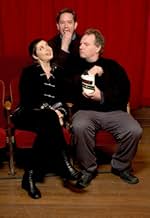The Saddest Music in the World
- 2003
- Tous publics
- 1h 40m
IMDb RATING
7.0/10
6.5K
YOUR RATING
A musical of sorts set in Winnipeg during the Great Depression, where a beer baroness organizes a contest to find the saddest music in the world. Musicians from around the world descend on t... Read allA musical of sorts set in Winnipeg during the Great Depression, where a beer baroness organizes a contest to find the saddest music in the world. Musicians from around the world descend on the city to try and win the $25,000 prize.A musical of sorts set in Winnipeg during the Great Depression, where a beer baroness organizes a contest to find the saddest music in the world. Musicians from around the world descend on the city to try and win the $25,000 prize.
- Director
- Writers
- Stars
- Awards
- 6 wins & 7 nominations total
Nancy Jane Drake
- American Mother
- (as Nancy Drake)
- Director
- Writers
- All cast & crew
- Production, box office & more at IMDbPro
Featured reviews
I saw Guy Maddin's film last weekend, not really knowing much about it other than it's premise, which was too absurd to pass up. A double amputee parapalegic beer baroness with glass legs filled with her own beer holding a contest during Prohibition to find the saddest music in the world? Where do people come up with this stuff?
The film is an interesting conglomeration of styles from films before and around the era in which it is set. The 8 mm footage with the stereopticon lens is reminiscent of the earliest films, and the distorted sets created in a studio are reminiscent of the German expressionist films. This is combined with a 30's musical and conversational style, including bits of "Technicolor" thrown in for good measure. I would have to see the film again, but I would like to go back and see it again to determine the link between the scenes which are suddenly shot in color as compared to the grainy black and white images that grace the rest of the film.
Despite the quizzical looks from the three fellow moviegoers who occupied the theatre, I found myself laughing out loud quite a few times at the film's caustic humor. The matches between the music from each country are like something out of a gangland film, with each side advancing toward each other menacingly during their performance. Some of the countries who perform in the competition reflect Maddin's satirical side, including a winning performance from Serbia (of all places) and an entry from the "country" of Africa (as if we in North America don't know any of the individual nations on the continent).
The entwining of satire and comedy continues in the musical performances and the competition's radio commentators. Maybe it's just me, but the funeral dirges from some countries (most notably "Africa" and Scotland) are not really "sad" at all, as they are a bit loud and a bit too upbeat. The greatest offender is the American entry, who turns the competition into a showcase for his Broadway ambitions, eschewing the premise of the competition with the blessing of Lady Port-Huntley, who incidentally is his former-current lover. The idiotic commentators obnoxiously chatter over a loudspeaker even as the musicians are performing, delivering such priceless wisdom as "Siam is known for its dignity, twins, and cats."
The themes of the film revolve around the separation between the rich and the poor (one character enjoys a psychic connection with her tapeworm), American excess, Canadian self-loathing, humanity's relentless desire for the trivial and superficial over the meaningful and spiritual, the global domination of American pop culture, how the mass media controls the world, etc. However, none of these are really fleshed out in the film, but rather touched on briefly then tossed away in favor of the next idea.
Though the film is more style over substance, it is still thoroughly enjoyable for anyone who loves the cinema in all its forms.
The film is an interesting conglomeration of styles from films before and around the era in which it is set. The 8 mm footage with the stereopticon lens is reminiscent of the earliest films, and the distorted sets created in a studio are reminiscent of the German expressionist films. This is combined with a 30's musical and conversational style, including bits of "Technicolor" thrown in for good measure. I would have to see the film again, but I would like to go back and see it again to determine the link between the scenes which are suddenly shot in color as compared to the grainy black and white images that grace the rest of the film.
Despite the quizzical looks from the three fellow moviegoers who occupied the theatre, I found myself laughing out loud quite a few times at the film's caustic humor. The matches between the music from each country are like something out of a gangland film, with each side advancing toward each other menacingly during their performance. Some of the countries who perform in the competition reflect Maddin's satirical side, including a winning performance from Serbia (of all places) and an entry from the "country" of Africa (as if we in North America don't know any of the individual nations on the continent).
The entwining of satire and comedy continues in the musical performances and the competition's radio commentators. Maybe it's just me, but the funeral dirges from some countries (most notably "Africa" and Scotland) are not really "sad" at all, as they are a bit loud and a bit too upbeat. The greatest offender is the American entry, who turns the competition into a showcase for his Broadway ambitions, eschewing the premise of the competition with the blessing of Lady Port-Huntley, who incidentally is his former-current lover. The idiotic commentators obnoxiously chatter over a loudspeaker even as the musicians are performing, delivering such priceless wisdom as "Siam is known for its dignity, twins, and cats."
The themes of the film revolve around the separation between the rich and the poor (one character enjoys a psychic connection with her tapeworm), American excess, Canadian self-loathing, humanity's relentless desire for the trivial and superficial over the meaningful and spiritual, the global domination of American pop culture, how the mass media controls the world, etc. However, none of these are really fleshed out in the film, but rather touched on briefly then tossed away in favor of the next idea.
Though the film is more style over substance, it is still thoroughly enjoyable for anyone who loves the cinema in all its forms.
And I thought `Dogville' was stylized. Canadian writer/director Guy Maddin ("Dracula: Pages from a Virgin's Diary,' "Archangel') has created a film like no other this year except possibly `Triplet's of Belleville.' `The Saddest Music in the World' is a `musical' set in Winnipeg in 1933, where Lady Port-Huntly (Isabella Rossellini) is holding a contest to award $25,000 to the saddest music performer. In `Depression Era dollars,' no less.
Winnipeg has been declared by the London Times `the world capital of sorrow' for the fourth year in a row. What happens in the film can be categorized as surrealism of the sort that marries the Melies brothers in their `Trip-to-the-Moon' wackiest to `The Twilight Zone' in Rod Serling's most hilarious (and that's pretty unusual) moments. Shot in distressed mode with 8 mm blown up to be grainy and silent movieish, `Saddest' has blue-grays and silvers and occasional bursts of washed-out color that give it an otherworldly cast meant to satirize the old movies and create a new look built on nostalgia and freedom from convention that some call expressionism.
Some of the bizarre acts vying for the prize are Fyodor (David Fox), a veteran of World War I representing Canada, who plays a deathlike version of ''The Red Maple Leaves'' on an upright piano he has turned over, and Indian singers in Eskimo costumes, who dance to ''California Here I Come'' with sitars and banjos commemorating a 19th-century kayaking accident. All the time an iris lens blurs the edges of the film to recreate the ancient look of film found in a vault after 50 years.
That Lady Port-Huntly needs artificial legs is not as bizarre as the back story of how she came to need them, and that the new glass legs have local beer coursing through them is just another creative and absurdist touch. With a resemblance to the robot in `Metropolis,' she is an amalgam of strange and prophetic moments in film and culture. I know I'm not making much sense here-Trust me that this film is bizarre enough to satisfy the geekiest cultist in our audience. For the rest of us, just trying to appreciate all the signposts Maddin constructs to further his absurd and funny vision is exhausting. Wordsworth's thoughts apply because we at least hear `the still, sad music of humanity.'
Winnipeg has been declared by the London Times `the world capital of sorrow' for the fourth year in a row. What happens in the film can be categorized as surrealism of the sort that marries the Melies brothers in their `Trip-to-the-Moon' wackiest to `The Twilight Zone' in Rod Serling's most hilarious (and that's pretty unusual) moments. Shot in distressed mode with 8 mm blown up to be grainy and silent movieish, `Saddest' has blue-grays and silvers and occasional bursts of washed-out color that give it an otherworldly cast meant to satirize the old movies and create a new look built on nostalgia and freedom from convention that some call expressionism.
Some of the bizarre acts vying for the prize are Fyodor (David Fox), a veteran of World War I representing Canada, who plays a deathlike version of ''The Red Maple Leaves'' on an upright piano he has turned over, and Indian singers in Eskimo costumes, who dance to ''California Here I Come'' with sitars and banjos commemorating a 19th-century kayaking accident. All the time an iris lens blurs the edges of the film to recreate the ancient look of film found in a vault after 50 years.
That Lady Port-Huntly needs artificial legs is not as bizarre as the back story of how she came to need them, and that the new glass legs have local beer coursing through them is just another creative and absurdist touch. With a resemblance to the robot in `Metropolis,' she is an amalgam of strange and prophetic moments in film and culture. I know I'm not making much sense here-Trust me that this film is bizarre enough to satisfy the geekiest cultist in our audience. For the rest of us, just trying to appreciate all the signposts Maddin constructs to further his absurd and funny vision is exhausting. Wordsworth's thoughts apply because we at least hear `the still, sad music of humanity.'
I spent the whole time asking myself whether I was enjoying this. I tried, but I'm still not sure. I did appreciate the film making. The director clearly asked 'what can we do with the camera?' and the answer was 'anything'. There were many beautiful shots that had me hitting the pause button. A lot of it had an experimental feel - but that wasn't the problem. The story, based on an original screenplay by Kazuo Ishiguro (perhaps they should have stuck to the original), felt like it was concocted by different people trying to outdo each other with silly ideas (tapeworms, beer-filled glass legs, sleeping in the snow, a character based on Gavrilo Princip - you quickly stopped asking why) - but that wasn't the problem either.
The film might have been a collaboration between David Lynch, Orson Welles, Eisenstein, and the Brothers Quay - each of them disagreeing what the film should be about. It was worth trying. I quickly got used to the extremely smudgy effect - as if the lens had been smothered in vaseline - and I appreciated Isabella Rosselini (looking and sounding like her mother) and the big-eyed Maria de Madeiros.
The backdrop was a music contest between international contestants to find the world's saddest music. The face-off heats was pure Python but it was all kept strangely distant. There were several problems: the emotional drama between the father and the two sons was dreary, as such issues always are. Secondly, it wasn't funny, and that was because it was all art and no emotional intelligence. Thirdly, it said nothing. It was full of ideas, but they were all microscopic, worked out at scene level - or even frame level. The whole thing put together didn't add up to anything. In the end, the images were everything, and that is always going to be disappointing.
The film might have been a collaboration between David Lynch, Orson Welles, Eisenstein, and the Brothers Quay - each of them disagreeing what the film should be about. It was worth trying. I quickly got used to the extremely smudgy effect - as if the lens had been smothered in vaseline - and I appreciated Isabella Rosselini (looking and sounding like her mother) and the big-eyed Maria de Madeiros.
The backdrop was a music contest between international contestants to find the world's saddest music. The face-off heats was pure Python but it was all kept strangely distant. There were several problems: the emotional drama between the father and the two sons was dreary, as such issues always are. Secondly, it wasn't funny, and that was because it was all art and no emotional intelligence. Thirdly, it said nothing. It was full of ideas, but they were all microscopic, worked out at scene level - or even frame level. The whole thing put together didn't add up to anything. In the end, the images were everything, and that is always going to be disappointing.
Guy Maddin just gets better and better. In this, his latest film, he's outdone himself. The fusion of content and style is so brilliant, clever, and emotional, the film has to rank as one of the best of 2004 even with the year not yet being half over.
Set in 1933, "the depths of the Great Depression", the location is Winnipeg, Canada, home of Lady Port-Huntly (Isabella Rosselini), the astoundingly wealthy beer baroness of Canada, who decides to hold a contest to select the saddest music in the world--for business reasons, of course. Among the entrants are her former lover, Chester Kent (Mark McKinney), his current lover Narcissa (Maria de Medeiros), Chester's estranged brother Roderick (Ross McMillan)--separated from Narcissa, and the men's father, Duncan (Claude Dorge). Duncan represents Canada; Chester, America; and Roderick, Serbia (of all places).
The prize is $25,000, a fortune in those days, so naturally there are entrants from all over the world--among which are Mexico, Siam, and Africa. The music is inspired, but eventually converges on the lilting popular American tune The Song is You, for which there are diverse renditions in the course of the film. The show-stopper is the version by Chester near the end, a big band production that fuses influences, in typical American fashion, from all over the world.
Familial tensions converge with unrequited love, and with the most peculiar prostheses anyone has ever seen--either in real life or on film. Lady Port-Huntly is a double amputee, and he whose reckless mistake resulted in her unfortunate current condition fashions for her a pair of legs that must be seen to be believed.
The entire film is shot using a blue-haze filter, with a faux stereopticon effect that narrows the viewing screen to that resembling what one would see from the early days of film, and with the faintest, subtlest and tiniest of lags in action-speech synchronization that makes this uncannily resonate as a work fusing a 30s setting, a pre-20s style, and a contemporary sensibility that knows how to combine these elements in the first place. This is a truly brilliant--I would even call it genius--approach to filmmaking that noone else in the known world even remotely approaches. Maddin is one of the contemporary masters of cinema and this is the proof.
As soon as this is available on DVD, I will buy it immediately. I suggest you do the same.
Set in 1933, "the depths of the Great Depression", the location is Winnipeg, Canada, home of Lady Port-Huntly (Isabella Rosselini), the astoundingly wealthy beer baroness of Canada, who decides to hold a contest to select the saddest music in the world--for business reasons, of course. Among the entrants are her former lover, Chester Kent (Mark McKinney), his current lover Narcissa (Maria de Medeiros), Chester's estranged brother Roderick (Ross McMillan)--separated from Narcissa, and the men's father, Duncan (Claude Dorge). Duncan represents Canada; Chester, America; and Roderick, Serbia (of all places).
The prize is $25,000, a fortune in those days, so naturally there are entrants from all over the world--among which are Mexico, Siam, and Africa. The music is inspired, but eventually converges on the lilting popular American tune The Song is You, for which there are diverse renditions in the course of the film. The show-stopper is the version by Chester near the end, a big band production that fuses influences, in typical American fashion, from all over the world.
Familial tensions converge with unrequited love, and with the most peculiar prostheses anyone has ever seen--either in real life or on film. Lady Port-Huntly is a double amputee, and he whose reckless mistake resulted in her unfortunate current condition fashions for her a pair of legs that must be seen to be believed.
The entire film is shot using a blue-haze filter, with a faux stereopticon effect that narrows the viewing screen to that resembling what one would see from the early days of film, and with the faintest, subtlest and tiniest of lags in action-speech synchronization that makes this uncannily resonate as a work fusing a 30s setting, a pre-20s style, and a contemporary sensibility that knows how to combine these elements in the first place. This is a truly brilliant--I would even call it genius--approach to filmmaking that noone else in the known world even remotely approaches. Maddin is one of the contemporary masters of cinema and this is the proof.
As soon as this is available on DVD, I will buy it immediately. I suggest you do the same.
'The Saddest Music in the World' is a kind of pastiche of 1920s film-making, with interspersed scenes in cod-Technicolour; but to really give a flavour of its oddness, I should say that it's the tale of an amputee brewery heiress with a pair of glass legs, filled up with beer (writer Kazuo Ishiguro borrowing from one of his own novels in the story of how she lost her originals). In truth, this is a very silly film, but it's almost a triumph, in that the silliness is controlled, with every crazy scene is consistent in tone and adding to the bizarre atmosphere. But it's hard to assert that the movie amounts to much more than a demonstration that it was technically possible to make it - it can't be taken seriously, and it's not really funny (rather, it's the sort of film that only makes you laugh because of its audaciousness in what it dares to pass off as comedy). But you certainly won't see too many other movies like it; and director Guy Maddin makes brilliant use of the heart-shaped face of Maria de Madeiros, which he makes look as if it really has just heard the saddest music ever.
Did you know
- TriviaSome actors are given an "additional camera" credit, as they shot footage on handheld Super8 cameras.
- Quotes
Lady Port-Huntley: If you are sad and like beer, I'm your lady.
- SoundtracksThe Song is You
Music by Jerome Kern
Lyrics by Oscar Hammerstein II
Used by permission of Universal - Polygram International Publishing, Inc.
- How long is The Saddest Music in the World?Powered by Alexa
Details
- Release date
- Country of origin
- Languages
- Also known as
- La canción más triste del mundo
- Filming locations
- Production companies
- See more company credits at IMDbPro
Box office
- Budget
- CA$3,500,000 (estimated)
- Gross US & Canada
- $699,225
- Opening weekend US & Canada
- $37,743
- May 2, 2004
- Gross worldwide
- $854,994
- Runtime1 hour 40 minutes
- Color
- Sound mix
- Aspect ratio
- 1.85 : 1
Contribute to this page
Suggest an edit or add missing content

Top Gap
By what name was The Saddest Music in the World (2003) officially released in India in English?
Answer






























